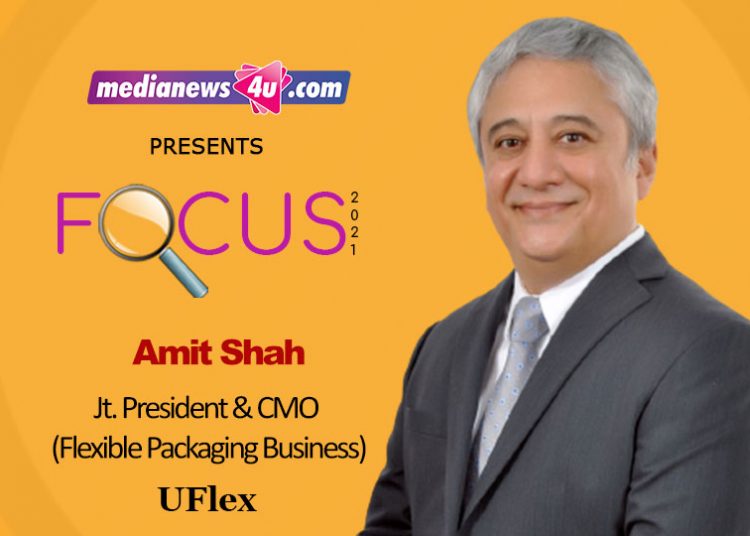Packaging done just right!
Amit Shah, Jt. President & Chief Marketing Officer (Flexible Packaging Business) UFlex.
After impact-driven efforts by brands via advertisement, consumer brands are coming together with the packaging players to customize the end-user experience and get closer to their consumers with every purchase they make. The packaging industry, consequently is working towards enhancing the ‘packaging’ aspect of product marketing. The key players of the flexible packaging industry are now focused on delivering packaging solutions that depict the journey of the product besides being sustainable, innovative and cost-effective.
Now, the mission is to come up with packaging solutions that meet the common interest of both parties, offering personalized appeal to every target consumer. With 2020 having shown the ability of flexible packaging industry to respond quickly and ensure an uninterrupted supply chain to meet market demands even in the face of a global health crisis, it is more important than ever to try and understand what 2021 will bring along for the industry.
Informing the consumers about cradle-to-cradle packaging
In a scenario of plastic pollution that is impacting our planet adversely, the challenge is to come up with flexible packaging innovation that promises to play a huge role in favour of the environment, and doesn’t add to the piling plastic packaging waste. The brand owners are constantly working towards ehanching communication with the end consumers on their commitment towards sustainability. The flexible packaging industry has started investing a lot more intelligence in an attempt to reduce their carbon and environmental footprint. Concepts like ‘cradle-to-cradle’ are soon expected to leap both perishable & non-perishable goods. Material re-utilization will be heavily focused on the waste that is either used in energy creation or is re-used for other products.
Intelligent packaging
Technology has emerged as a key enabler to facilitate interactive communication with packaging. Brand owners today have the opportunity to use various interactive formats on their packaging e.g scanning codes and smart labels for personalized information, journey, product tracking and even tips on how to use the product that they wish to provide to the consumer. This way, users learn a lot more about the product that companies can provide over their packaging.
Design and convenience packaging
Brands are not limiting their customers to become mere a buyer but are working hard towards leaving a topic of discussion on the social (online & offline) platforms, creating an experience. Designs that are highly customized and can pinpoint the major problems faced by the consumers will continue to rise. Stories and quotes on the outer covers to engage consumers to create a long-lasting image are here to stay.
Promotion of better hygiene and biosafety
The outbreak of COVID-19 and its resulting economic impact disrupted some well-established supply chain of consumer and pharma brands. On the one hand, it created delays and shortages that affected many businesses that needed to package and make their products easily accessible to end-consumers. Simultaneously, a growing number of consumers started to focus on the importance of bio-safety as a packaging issue, especially for food and beverage products. So products that were not packed earlier may now require packaging in order to reassure customers about the ability of the brands to protect goods from contact with coronavirus.
Expected to be an over $1 trillion industry by 2021, the packaging industry is trying hard to make a difference. The aim for the future is to bring awareness to a consumer about green packaging alongside, adding a look and feel that makes a product purchase worthy, personalized, harmless, and durable. Moreover, for something that reaches almost every human being on the planet, packaging surely needs to be changed for the greater good.

















